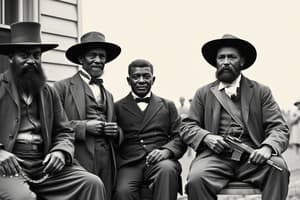Podcast
Questions and Answers
How were scalawags different from carpetbaggers?
How were scalawags different from carpetbaggers?
- Both were the same groups.
- Scalawags were Democrats who betrayed the South. (correct)
- Carpetbaggers were people who rushed to the South carrying possessions in bags. (correct)
- Scalawags supported the Confederate government.
How did African Americans participate in government during Reconstruction?
How did African Americans participate in government during Reconstruction?
They were the largest group of Republican voters in the South, with over 600 winning state legislatures and some holding local offices.
Why did Southern Reconstruction governments focus on building railroads and bridges?
Why did Southern Reconstruction governments focus on building railroads and bridges?
To help the Southern economy recover from the war.
Why did resistance to Reconstruction increase?
Why did resistance to Reconstruction increase?
How did the government address the activities of the Ku Klux Klan?
How did the government address the activities of the Ku Klux Klan?
How was the United States affected by the Panic of 1873?
How was the United States affected by the Panic of 1873?
What issues caused the Republican Party to abandon Reconstruction?
What issues caused the Republican Party to abandon Reconstruction?
Who were the redeemers?
Who were the redeemers?
In what ways were African Americans restricted from voting?
In what ways were African Americans restricted from voting?
How did segregation become a key issue in Plessy vs. Ferguson?
How did segregation become a key issue in Plessy vs. Ferguson?
Why did African Americans stay on plantations?
Why did African Americans stay on plantations?
Why would the cycle of debt continue as sharecroppers?
Why would the cycle of debt continue as sharecroppers?
What were the benefits and drawbacks of mill work?
What were the benefits and drawbacks of mill work?
What was the most successful industrial development in the South after Reconstruction?
What was the most successful industrial development in the South after Reconstruction?
Who was Hiram Revels?
Who was Hiram Revels?
What was the Compromise of 1877?
What was the Compromise of 1877?
Flashcards are hidden until you start studying
Study Notes
Differences Between Scalawags and Carpetbaggers
- Carpetbaggers: Northerners who moved to the South with their belongings in bags made of carpeting, often perceived negatively by Southerners.
- Scalawags: Southerners who supported the Republican Party, seen as traitors by Democrats, often described as "greedy rascals."
African American Participation in Government
- Largest group of Republican voters in the South during Reconstruction.
- Over 600 African Americans elected to state legislatures.
- 16 African American politicians elected to Congress.
- Numerous African Americans held local office positions throughout the South.
Focus on Infrastructure in Reconstruction Governments
- Southern governments prioritized building railroads and bridges to boost the post-war economy.
- Funding for projects obtained through raised taxes and issued bonds.
Increase in Resistance to Reconstruction
- Claims of corruption and illegitimacy regarding new governments expressed by some Southerners.
- Discontent regarding African American officeholders and the presence of federal troops.
Government Response to Ku Klux Klan Activities
- Laws enacted by Congress to criminalize election interference and deny citizens equal protection under the law.
Impact of the Panic of 1873 on the United States
- The Republican Party blamed for the economic crisis.
- Nearly 18,000 businesses declared bankruptcy leading to increased unemployment and protests.
Republican Party Abandonment of Reconstruction
- Concerns over economic issues and corruption led to declining party support.
- Loss of control in the House of Representatives marked a shift in power.
Redeemers and Control of Southern Governments
- Democrats regained control over Southern state governments following the end of Reconstruction.
Restriction of African American Voting Rights
- Poll taxes and literacy tests imposed barriers to voting, disproportionately affecting African Americans.
Segregation in Plessy v. Ferguson Case
- The case centered around Plessy, an African American who refused to vacate a whites-only section of a train, highlighting racial segregation issues.
African Americans Remaining on Plantations
- Economic factors, such as the cost of farming, made staying on plantations a more viable option than renting or relocating.
Cycle of Debt for Sharecroppers
- Continuous issues like poor weather and low crop prices created an inescapable cycle of debt for sharecroppers.
Mill Work: Benefits and Drawbacks
- Benefits: Employment for families, value of women workers, alternative to agriculture.
- Drawbacks: Long hours, risk of injury, exposure to health hazards like brown lung disease, and limited opportunities for advancement.
Textile Production Post-Reconstruction
- Emerged as the most successful industrial development in the Southern economy after Reconstruction.
Hiram Revels
- Notable as the first African American to serve in the U.S. Congress, marking a significant milestone in political representation.
Compromise of 1877
- Agreement that resolved the 1876 presidential election, awarding the presidency to Hayes in exchange for the withdrawal of federal troops from the South, effectively ending Reconstruction.
Studying That Suits You
Use AI to generate personalized quizzes and flashcards to suit your learning preferences.


